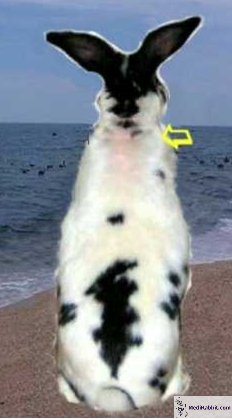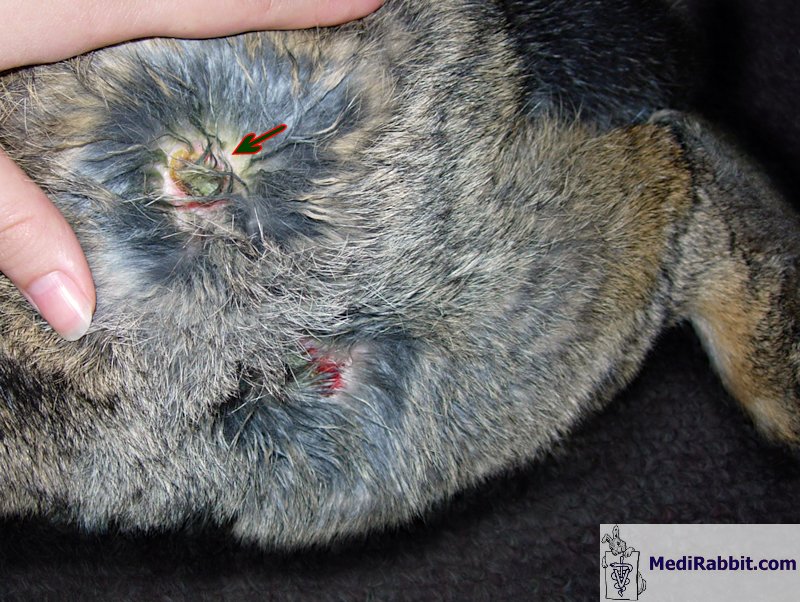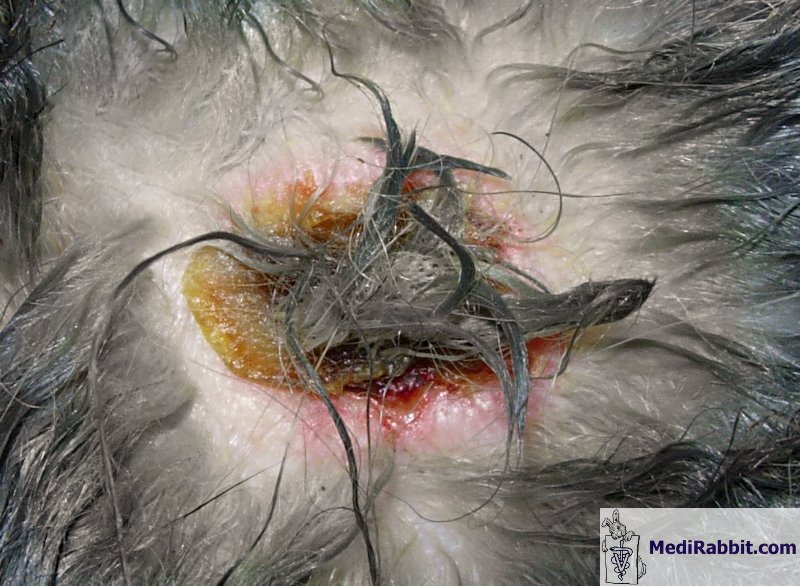Antibiotics safe for use in rabbits
|
MediRabbit.com is
funded solely by the generosity of donors. Every
donation, no matter what the size, is appreciated and will aid in the
continuing research of medical care and health of rabbits. Thank you |
Skin irritation or formation of sterile abscesses
after subcutaneous injection of antibiotics like penicillin or enrofloxacin (Baytril) is possible. When the antibiotic is dissolved in
a water-based solution, e.g., enrofloxacin, the formation of sterile
abscesses can be avoided by diluting the amount to be given by the same
amount of a sterile saline solution. Beside sterile abscesses, the use of Baytril over longer periods of time may lead to muscle
necrosis. Fluoroquinilone antibiotics can moreover lead to cartilage damage
of the cartilage and damage of joints (arthropathy)
when used over a longer period in young rabbits. |
|
|
|
|
Ivana Milošević
Sterile abscess in a rabbit, after
injection of enrofloxacin |
|
|
Name of antibiotics |
Remarks |
Dosage
|
Way
|
Frequency
|
|
Amikacin |
Nephrotoxic
in dehydrated rabbits. |
5-10 mg/kg |
SC, IM, IV |
sid, bid,
tid |
|
8-16 mg/kg |
SC, IM, IV |
sid, bid,
tid |
||
|
Amoxicillin (see: Remarks) |
*ONLY* as injection, never
orally. Has recently been successfully used in
rabbits, to treat infections due to bacteria, whose sensitivity tests
indicate that amoxillin is the only effective
antibiotic, e.g. osteomyeltitis. No adverse reaction has been noted with
injected treatment. *Never* give orally; this has fatal consequences. Is used sometimes to treat
treponematosis. |
7 mg/kg |
SC |
q 24h or
every second day |
|
Azithromycin |
Recommended for difficult to treat URI. May lead to a reduction of appetite. |
30-50mg/kg |
PO |
sid |
|
Bicillin in Units (penicillin G procaine and penicillin G
benzathine) (see: Remarks) |
*ONLY*
as injection. for treatment of bacterial infections. In rare cases, penicillin
treatment leads to: - a decreased appetite, - the formation of
sterile abscesses. |
47.000 -
84.000 IU/kg |
SC |
Depending on
the type of infection, daily or every 2nd day. To avoid
problems of the digestive system (dysbiosis),
probiotics can be given twice a day |
|
Bicillin in mg/kg (penicillin G procaine and penicillin G
benzathine)
(see: Remarks) |
*ONLY* as injection. for treatment of bacterial infections. In rare cases, penicillin
treatment leads to: - a decreased appetite, - the formation
of sterile abscesses. |
20 mg/kg
(procaine) + 15 mg/kg
(benzathine) |
SC |
q 2nd/3rd day |
|
Cephalexin (see: Remarks) |
*ONLY* as injection. Normally no cross reaction with
Penicillin, in some cases of renal failure > nephrotoxic |
15-20 mg/kg |
SC
|
bid, tid |
|
20 mg/kg |
SC |
sid |
||
|
Chloramphenicol |
Exceptionally leads to a decreased
appetite |
30-50 mg/kg |
PO, SC, IM |
bid |
|
15 mg/kg |
PO |
bid |
||
|
Chlortetracycline |
. |
50 mg/kg |
PO |
bid |
|
Ciprofloxacin |
Hindered absorption, when concurrent administration
of antacids. High dosage treatment (20 mg/kg) over a
longer period of time may lead to seizure |
5-20 mg/kg |
PO |
sid, bid |
|
Clopidol |
. |
200 mg/kg food |
. |
. |
|
Danofloxacine |
. |
1-5 mg/kg (?) 5 mg/kg (?) |
IM SC |
. |
|
Difloxacine |
. |
5-10 mg/kg (?) 2,5-5 mg/kg |
PO SC, IM |
. |
|
Dimetridazole |
. |
0.2 mg/ml water |
PO |
q 12 h. |
|
Doxycycline |
. |
2.5 mg/kg |
PO |
bid |
|
4 mg/kg |
PO |
sid |
||
|
Enrofloxacin |
High dosage treatment (20 mg/kg) over a
longer period of time may lead to seizure. Cartilage damage in juvenile rabbits. In rare cases, enrofloxacin leads to: - decreased appetite, - formation of
sterile abscesses, if injected. This can be avoided by diluting the solution
with a sterile saline solution, 50:50. |
5-15
mg/kg
|
|
bid - sid
|
|
Fusidic acid |
In
eye ointment |
1 drop/eye |
. |
. |
|
Gentamycin |
Best avoided for use in rabbits Depending on dosage: Ototoxicity Nephrotoxic, neuromuscular block |
5-8 mg/kg |
SC, IM, IV |
q 8-12 h. |
|
1-2 drops/eye |
topical |
bid |
||
|
Marbofloxacine |
Cartilage
damage in juveniles High dosage treatment (10 mg/kg) over a
longer period of time may lead to seizure |
2 – 5 mg/kg |
PO, SC, IV |
sid |
|
Metronidazole |
3
to 5 days |
15-20 mg/kg |
PO |
bid |
|
Neomycin |
Depending on dosage: ototoxicity Nephrotoxic, neuromuscular block |
30 mg/kg |
PO |
bid |
|
Oxytetracycline |
. |
15 mg/kg |
SC, IM |
sid, tid |
|
50 mg/kg |
PO |
bid |
||
|
Penicillin G procaine for bacterial infections, e.g. abscesses, middle ear infections, etc.
|
*Only* as injection. SC pathway should be favored for owners
giving the treatment at home. IM administration only for professionals
and veterinarians. |
20.000 –
60.000 IU/kg |
SC, IM |
q 24-48 h. If bacterial
infection: daily administration, or every 2nd day. |
|
Penicillin G
procaine (long lasting) in the treatment of
rabbit syphilis (Treponematosis)
|
*Only* as injection. SC pathway should be favored for owners
giving the treatment at home. |
80.000 IU/kg,
once weekly (1x per week), during 3 to 5 weeks OR (40,000-60,000 IU/kg, every day
(q24h) for 5 to 7 days |
SC |
IM injection is possible, but only by a
veterinarian. |
|
Robenidine |
. |
50-66 mg/kg feed |
. |
. |
|
Spiramycin (see: Remarks) |
Recommended for difficult to treat URI Cecal enlargement has been observed, with dosage of 200 and 400 mg/kg |
1 ml/kg 25 mg/kg |
SC, IM |
. |
|
Streptomycin |
Depending on dosage: Ototoxicity Nephrotoxic, neuromuscular block |
50 mg/kg |
IM |
sid |
|
Sulfadimidene |
. |
1 – 5 mg/ml water |
. |
.. |
|
Sulfamethazine |
. |
100-233 mg/l water |
. |
. |
|
Tetracycline |
May lead to a reduction of appetite. |
50 mg/kg |
PO |
q 8-12 h. |
|
Trimethoprim Sulfa |
. |
30-40 mg/kg |
PO |
bid |
|
48 mg/kg |
SC |
bid |
||
|
Toltrazuril |
q 24 the first 2 days, repeat after 2
days |
25 mg/kg |
PO |
q 24 h. |
|
Tylosin (see: Remarks) |
A test dose of 5 mg/kg should be give to check that no adverse reaction takes place. |
10 mg/kg |
PO, SC, IM |
bid |
for the meaning of
the abbreviations, click here.
Further information
Dana G.
Allen, J. K Pringle, Dale A. Smith, Handbook of Veterinary Drugs. Lippincott
– Raven 1998. Elizabeth V. Hillyer and Katherine E. Quesenberry,
Ferrets, Rabbits, and Rodents: Clinical Medicine and Surgery. New York: WB Saunders
Co. 1997. Frances
Harcourt-Brown, Rabbit Medicine and Surgery. Butterworth-Heinemann 2001. Kathy Laber-Laird, Paul Flecknell and
M. Michael Swindle, Handbook of Rodent and Rabbit Medicine. Oxford, UK: Pergamon Press 1996. John E.
Harkness and Joseph E. Wagner, The Biology and Medicine of Rabbits and
Rodents. New York: Lippincott Williams & Wilkins 1995. Paul Flecknell, BSAVA Manual of Rabbit
Medicine and Surgery. British Small Animal Veterinary Association
2000.Virginia Richardson, Rabbits: Health, Husbandry and Disease, Blackwell
Science Inc. 2000. H. Schall,
Kaninchen, In: Krankheiten der Heimtiere (K Gabrisch & P Zwart, eds),
Schlütersche & Co, Hannover (D); pp 1-45, 1998 |
e-mail: info@medirabbit.com






